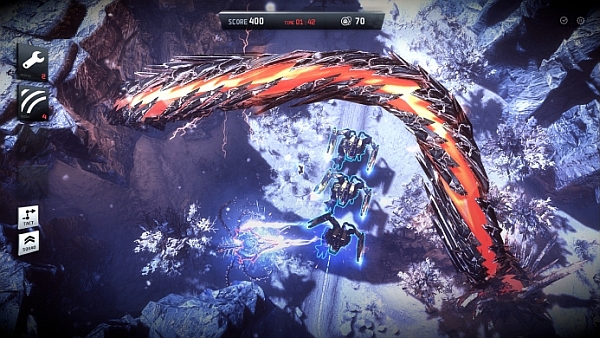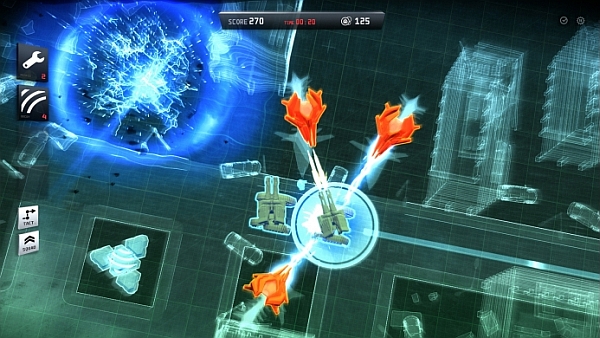
The original Anomaly: Warzone Earth turned the tower defense genre upside-down – literally, because you played as the creeps fighting against the towers. It was a fun, challenging and popular game, with fans demanding a sequel. Well, Polish developer 11 Bit Studios has happily complied with the aptly named Anomaly 2, highlighted by its killer feature: creeps versus towers multiplayer.
Platforms: PC (Version Played), Mac, Linux
Publisher: 11 Bit Studios
Developer: 11 Bit Studios
Genre: Tower Defense (and Offense)
Release Date: May 15, 2013
ESRB Rating: Teen
 11 Bit took the “2” in the title and ran with it, doubling the number of squad vehicles and enemy towers, and (with mixed results) doubling the game’s complexity. Rather than simply pick your favorite units based solely on damage or defense, you now have to consider long- and short-range capabilities, slow and rapid fire, and what support units you need.
11 Bit took the “2” in the title and ran with it, doubling the number of squad vehicles and enemy towers, and (with mixed results) doubling the game’s complexity. Rather than simply pick your favorite units based solely on damage or defense, you now have to consider long- and short-range capabilities, slow and rapid fire, and what support units you need.
It can be daunting at first, but it helps that some vehicles do double duty by “morphing” into a different type, allowing you to instantly adjust your tactics on the fly. For example, the basic rapid-fire machine gun unit can be morphed into a mech with dual flamethrowers, perfect for attacking towers on both sides of your route. The long-range, slow-firing cannon unit (which is hampered by a very narrow shooting angle) can be morphed into a rocket launcher (with a much shorter, but 360-degree, firing range). New support units can turn your squad invisible, slow enemy targeting, and boost your Commander’s abilities.
As in the original, you directly control the Commander, who deploys abilities to help your AI-controlled squad. The Repair and Decoy abilities return, along with the new EMP, which stuns towers, and A.I.M., which directs your entire squad to attack a specific target. Unfortunately, the new abilities feel much less useful than the ones they replaced, the Smoke Screen and Smart Bomb.
Still, you will need everything you have to take on the new enemy towers, which include shielded turrets (strong against slow-firing units), “hidden” towers that suddenly pop up in clusters, and another that sits passively absorbing your shots. The problem with this last one is that the faster it absorbs damage, the faster it builds energy. Once that energy reaches a critical point, it transforms into an extremely powerful tower that can wreak serious havoc on your squad, so it’s important to only use slow-firing units on this sucker – which doesn’t sound like a problem, except when you’re surrounded by other towers that are more susceptible to rapid-fire units.

Right off the bat, it’s clear that figuring out the right mix for your squad requires a lot more tactical thinking than before. You will be morphing, selling and buying units on the fly constantly, because if you don’t, your squad will have a very bad day. This big jump in complexity and strategic planning skews the game heavily towards the hardcore RTS player, and could turn off the more casual tower defense fan. While the original was certainly not a casual title (it was, in fact, quite challenging at times), it was still fairly accessible. However, the same can’t be said for the sequel.
The campaign is roughly the same length as the original (around six to eight hours, depending on your play style), taking place in New York (complete with the requisite post-apocalyptic ruins of the Statue of Liberty), Rio de Janeiro and the Antarctic. The story is as threadbare as before: the aliens have returned and wiped out the planet, while the survivors make a final push to destroy their damned towers once and for all. The corny dialogue is exacerbated by even cornier voice acting (yes, even worse than the original), but you’re not playing for the story – you just want to blow the crap out of towers, and it’s as fun as ever. Fortunately, the music and sound effects are top notch, so your ears only suffer when someone’s talking.
Of course, the big draw is the new multiplayer mode pitting one player as the squad, and the other as the towers. The squad player has an experience similar to the campaign, using the Commander to protect their squad by applying abilities. You have a brief heads-up on where your opponent is planting towers, as they appear in a ghost form before they are fully constructed (towers take a few seconds to “build”) and so can adjust your route accordingly.

The tower player takes on the more traditional tower defense role by building units in pre-determined spots, upgrading them, and applying abilities like Regen (repairs your towers), Berserk (increases damage, but also damages you), Taunt (draws all squad fire but provides a protection bonus) and the self-explanatory Kamikaze. Towers can also emit energy waves that can slow the squad, drop their shields, or negate any deployed abilities. You can’t see the squad’s planned route, but can easily see them chugging along on the map, and thus can anticipate where they’re going. There are obvious destinations, like mineral deposits which will boost squad dollars (required to buy and upgrade units) and power generators. The goal of the squad is to destroy the generators, while the towers try to rack up kills. Every kill on both sides earns points, and the side that earns the most points wins.
Even though the squad’s speed is set at a rather leisurely pace, things get really frantic, really fast. Imagine the most intense moments in any tower defense game multiplied by a factor of ten. Yes, the game mechanics are the same as fighting against AI, but everything gets ramped up when you are against another human being. Unexpected tactics, surprise curveballs, clever twists – it’s all there when competing against another person. There is a lot of frenzied mouse clicking as you simultaneously try to keep units repaired while dishing out as much damage as possible.
It’s a lot of fun, but is quite overwhelming at first. Newbies are pretty much toast from the get-go, thanks primarily to the aforementioned huge jump in complexity. Combine that with the surprisingly rapid pace of each skirmish (which will have you clicking like a madman), the more casual player will feel like they are in over their heads. The hardcore fan will love it, however, and I can certainly see how this game could gain a loyal niche following.
Graphically, the game looks fantastic. The artwork has taken a big step up, with nastier-looking enemy towers covered in creepy, undulating tentacle thingees, and maps filled with crumbled buildings. The only downside is the occasional structure that blocks your view of the road – and your squad. You can still interact with the squad, but since you can’t see them, you can sometimes place your abilities in the wrong place or accidentally morph the wrong unit.
So does doubling everything equal double the fun? While Anomaly 2 does offer more alien blasting fun, the increase in complexity will only appeal to the more hardcore strategy fan, especially the enjoyable but challenging multiplayer mode. Still, if you’ve always wanted to go head-to-head with someone in squad versus towers combat, look no further.

Review Disclosure: A review copy of Anomaly 2 was provided by 11 Bit Studios for the purposes of this review.







